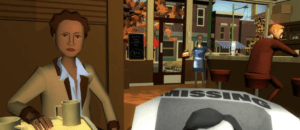Name: Virginia
Creator: Variable State, published by 505 Games
Target audience: My guess is that its PG-13 because of the story and the visual elements
Platform: PC (Steam), also available on Playstation, Xbox, tablets

How is narrative woven into the mystery through its mechanics? How does the architecture of the setting control the story? Then, look for loops and arcs. Does this game have one, both or something else?
How does the game weave mystery into the narrative?
Using specific art and design choices:
The game is designed around an FBI agent’s life who just got out of a training academy. The opening scene is in front of a bathroom mirror where the agent is looking at herself. This itself is a great start to make the player wonder what’s about to happen next. The background music does a good job at maintaining the atmosphere of suspense and thrill.

Using the game mechanics:
The mechanics of this game are minimalistic where the player can only move, and interact with objects in a single way that is pre-determined. The only flexibility that the player has is to decide whether or not to interact, once the decision to interact is made the character interacts unambiguously without giving any choice to the player. This is a design choice which supports the element of mystery – not being able to fool around keeps the player onto their toes and the player continues to stay engrossed in the game always anticipating the next set of events. As a designer it must have been a difficult choice to make given that so many different actions could have been enabled at different points in the game, for example when the character is driving, the player could be given the autonomy to drive wherever the player wants to, however, the designer chose to not give that autonomy to the player thereby eliminating any digression from the narrative.
Another interesting design choice is that there are no dialogues or texts in the entire game. As a result, a player must follow the narrative from the visual scenes being shown. As a player, this can be nerve-racking as sometimes the interpretations are not-so-obvious. The designers came up with a script before designing the game, but then decided to not have any texts in the game which implies that it was a conscious decision made to reduce distractions for the player.
The over-arching theme of minimalism can be seen in the entirety of the game aimed at reducing any digression from the narrative – be it mechanics, lack of dialogues, jump cuts and transitions across different scenes.

How does the architecture control the story?
The game seems to follow a mix of embedded, evocative and enacting narratives.
Its embedded because it clearly has two stories being explored at the same time – one of the investigation of the missing person, and the other of Marie’s (Anne’s partner) suspicious behavior. The player is left to deduce what might be the reasons for Marie to behave in such a strange way, leading to the player coming up with guesses which keep getting tuned over time. For example, when the locket with the picture of a lady is found by the player, the player is left with unanswered questions following the principles of an embedded architecture as described in the class reading.
Its evocative because it reminds me of all the suspense and thriller movies related to crime and investigation. For example, the opening scene with the character staring at themself in the mirror comes as a strong kick which brings back the memories of these movies.
Finally, it is also enacting because the player embodies the central character who is Anne in this case, an FBI agent. While the mechanics are minimalistic and the emphasis is not to act like a stereotypical FBI agent which might involve shooting and fighting, the interaction with case files, investigating apartments, looking for clues, confronting the tough partner who behaves suspiciously makes the player feel that they are Anne themself.
The game follows the world-building principles as taught in class. There is a clear map for the player to refer to, which allows the player to get a sense of the space in which they are playing. Also, the world is similar to the real world in many ways which was a point mentioned during class discussion.
The game also follows the story-writing technique which we tried during class with Christina. There is clearly a GMC (goal, motivation, conflict) for the character. The plot has a premise and a bunch of twists (the try-fail pairs) and there is also a vague resolution towards the end. The plot is clearly spread out across different locations on the map, as we see the character moving around and solving different issues related to the case.

Loops and arcs?
Clearly, the game has loops and arcs as we see references being made to the history of the characters involved in the game leading to a peek into their past lives and giving the story to the player in bits and pieces. This is an interesting design choice as the alternative could have been to introduce the character in totality from the very beginning but that reduces the fun of uncovering the story while making progress in the game. For example, when the player discovers a locket with a female’s picture on it, it is a reference to the past life of Marie and the player has to guess who this person might be, what the relationship might be and how this information would affect the gameplay.
This game is like watching a movie where the player is one of the actors, and they must interact with the environment to let the movie roll.





